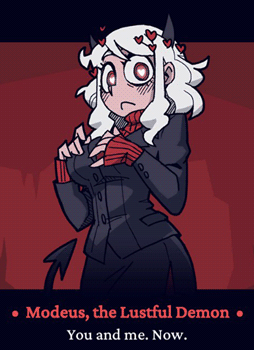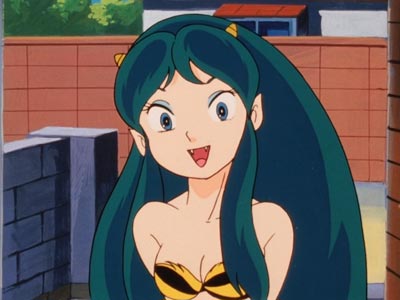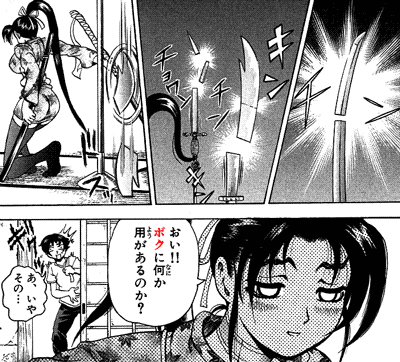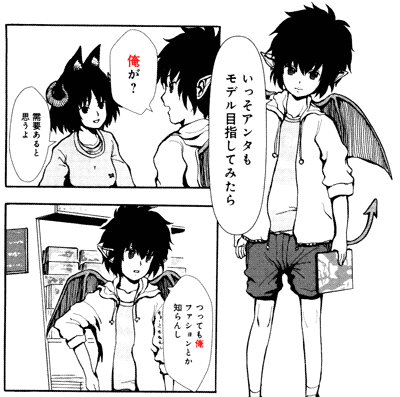In Japanese, ~kko ~っ娘 is a suffix attached to an attribute to refer to a type of girl that features that attribute, e.g. meganekko メガネっ娘 is a girl that wears "glasses," megane メガネ. For reference, this article will list some of such types of girls.
The suffix is also spelled ~kko ~っ子, ~kko ~っこ
- Meaning
- Meganekko メガネっ娘
- Bukikko 武器っ娘
- Robokko ロボっ娘
- Kemokko 獣っ娘
- Mimikko 耳っ娘
- Akumakko 悪魔っ娘
- Onikko 鬼っ娘
- Tsunokko 角っ娘
- Dojikko ドジっ娘
- Haitakko 歯痛っ娘
- Bokukko 僕っ娘
- Orekko 俺っ娘
- Warekko 我っ娘
- Dazekko だぜっ娘
- Negikko ネギっ娘
- Yurikko 百合っ娘
Meaning
The suffix ~kko ~っ娘 means literally "girl," but why the suffix works the way it does is a bit complicated.
To start with, ko 子, meaning "child," is sometimes used as a diminutive variant of hito 人, "person," in the sense that it's used to refer to people younger than you, and it's specially used by women, and specially used to refer to women and girls.
When it refers to a girl, ko 子 can be spelled with the kanji for musume 娘, "daughter," "young girl," instead. That's how you get ko 娘, which is a gikun reading.
When words are suffixed to other words, sometimes a small tsu っ is added at morpheme boundary (sandhi) to separate them, creating a change in pronunciation from ~ko ~娘, to ~kko ~っ娘.
Without the small tsu, 娘 is sometimes read as musume instead. For example: tsuno-musume 角娘, and tsunokko 角っ娘.
Exceptionally, otokonoko 男の娘, "male girl," a girl whose attribute is that she's male, i.e., a boy that looks like a girl, follows the same idea, but replaces the non-suffix ko 子 of {otoko no} ko 男の子, "child [that] {is male}," "{male} child," "boy."
Meganekko メガネっ娘
A meganekko メガネっ娘 is a girl that wears "glasses," megane 眼鏡. A glasses girl.
- kemomimi meganekko
ケモ耳メガネっ娘
Furry-ears glasses-girl. - megane
眼鏡
Glasses. (that you wear.)
Also spelled: 眼鏡っ娘, メガネっこ, 眼鏡っこ, メガネっ子, 眼鏡っ子.
Bukikko 武器っ娘
A bukikko 武器っ娘 a girl that brandishes a "weapon," buki 武器, or, in some cases, is the weapon itself. For example, like characters from Kantai Collection, who are all battleships.
See also: moe anthropomorphism.
Also spelled: 武器っ子.
Robokko ロボっ娘
A robokko ロボっ娘 is a girl that's a "robot," robotto ロボット. A robot girl.
Also spelled: ロボっ子.
Kemokko 獣っ娘
A kemokko 獣っ娘 is a girl that's a "beast," kemono 獣. In other words: a furry character.
Also spelled: 獣っ子.
Mimikko 耳っ娘
A mimikko 耳っ娘 is a girl with "ears," mimi 耳. An eared girl.
...?
Wait, what? A girl with ears???? What's so special about that?
Okay, it's not just ears, it's "beast ears," kemonomimi 獣耳. A mimikko is a girl with kemonomimi ears.
Right: "Village Girl," Mura-musume 村娘
Manga: Kemono Michi けものみち (Episode 8)
- Context: Shigure makes a money gesture.
Also spelled: 耳っ子.
Akumakko 悪魔っ娘
An akumakko 悪魔っ娘 is a girl that's a "demon," akuma 悪魔. A demon girl.
Game: Helltaker, ヘルテイカー
- Context: Helltaker is game about making a harem of sharply dressed (e.g. OL) demon girls, of which the permanently heart-eyed demon Modeus is a character of.
Also spelled: 悪魔っ子.
Onikko 鬼っ娘
An onikko 鬼っ娘 is a girl that's an oni 鬼, a certain spirit creature from Japanese folklore typically depicted with triangular horns.
Anime: Urusei Yatsura うる星やつら (Episode 1, 町に石油の雨がふる)
Also spelled: 鬼っ子.
Tsunokko 角っ娘
A tsunokko 角っ娘 is a girl with a "horn" or "horns," tsuno 角.
There are various types of girls that can end up having horns for whatever reason, some are oni, others are demons, others are partially animal, etc.
Also spelled: 角っ子.
Dojikko ドジっ娘
A dojikko ドジっ娘 is a girl that makes "blunders," doji ドジ, that is, a clumsy girl.
Also spelled: ドジっ子, ドジっこ.
A gojikko 誤字っ娘 is a dojikko tht makes "typos," goji 誤字.
Haitakko 歯痛っ娘
A haitakko 歯痛っ娘 is a girl with haita 歯痛, also read shitsuu 歯痛, which means "toothpain." So a toothpain girl.
Wait, what? This... this is a thing? Why is this even a thing? How many illustrations are there about this? Four hundred??? What?! I... I don't... what?
I can't believe this.
Bokukko 僕っ娘
A bokukko 僕っ娘 is a girl that uses the masculine first person pronoun boku 僕, which isn't normally used by girls.
- Context: Kousaka Shigure 香坂しぐれ, a ninja-esque swords and weapons master, practices the fine art of cutting blades with a blade.
- chi, kin, chin, kyoun, kin
チン キン チン キョウン キン
*sound effect of blades being cut.* - dosu'
ドスッ
*sound effect for blade falling in the tatami floor.* - oi!! boku ni nani ka you ga aru no ka?
おい!!ボクに何か用があるのか?
Hey!! Do [you] have any business with me? - giku'
ギクッ
*gulp* - a, iya, sono...
あ、いや その・・・
Ah, erm, that is...- All these three words are interjections.
Also spelled: 僕っ子, ボクっ娘, ボクっ子.
Orekko 俺っ娘
An orekko 俺っ娘 is a girl that uses the first person pronoun ore 俺. In most regions of Japan, this is a masculine pronoun, but there are a few regions in which it's acceptable for girls to use ore 俺.
Such characters tend to be masculine in one way or another.
- Context: Gokuraku Nozomi 獄楽希, a monster girl that looks like a boy, checks a fashion magazine that seems to feature one of her friends in the cover.
- isso anta mo moderu φ mezashite-mitara
いっそアンタもモデル目指してみたら
How about [you] try to become a model, too?
- ~te-mitara - ~tara ~たら form of ~te-miru ~てみる, "to try to."
- ore ga?
俺が?
Me? - juyou aru to omou yo
需要あると思うよ
[I] think there's demand.- For a model that looks like a boy.
- tsuttemo ore fashon toka shiran shi
つっても俺ファションとか知らんし
[Even if you say that], I don't know [anything about] fashion.- tsuttemo - contraction of to-itte mo と言っても.
Also spelled: 俺っ子, オレっ娘, オレっ子.
Warekko 我っ娘
A warekko 我っ娘 is a girl that uses ware 我 as first person pronoun.
Also spelled 我っ子.
Dazekko だぜっ娘
A dazekko だぜっ娘 is a girl that ends phrases in daze だぜ, which is the da だ copula plus the masculine ze ぜ sentence ending particle.
Also spelled: だぜっ子.
Negikko ネギっ娘
A negikko ネギっ娘 is a girl that somethings "green onions," negi 葱... wait what? Nope. That's not what it means at all! It's an idol group that's called Negikko, and the term refers either to the group itself or their green-onion-holding mascot character.
Yurikko 百合っ娘
A yurikko 百合っ娘 is a girl character who likes another girl, i.e. a lesbian character. This word comes from the term yuri 百合, a girl-x-girl manga genre.
Also spelled: 百合っ子, ユリっ子, ユリっ娘.






No comments: